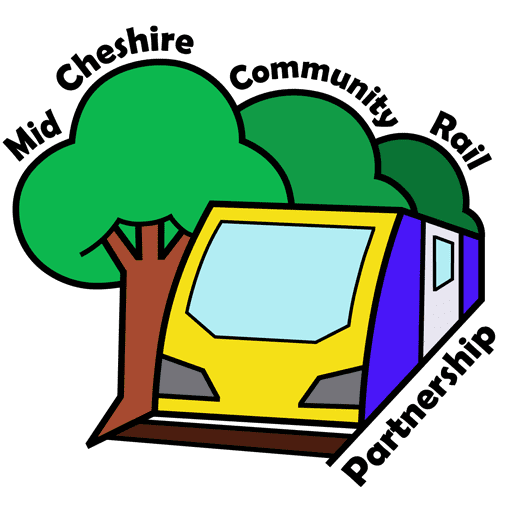Until the opening of the West Cheshire Railway to Helsby in 1869, Northwich was the terminus of the line from Altrincham. To provide facilities for locomotives arriving and starting here a small locomotive shed was built. Even at the time it must have been obvious that the shed, capable of holding only one locomotive, was completely inadequate, even taking into account that there was a two track locomotive shed at Knutsford to share some of the work.

Map of Northwich locomotive shed, 1867. Sited adjacent to the Northwich terminus of the Cheshire Midland Railway, this small single track shed (probably built in 1863) would only be able to house one locomotive. There is also a 45ft turntable, and a ‘coke stage’. At this time many locomotives still burned coke, although this soon gave way to the cheaper coal. This small structure was located on what is now the Tesco car park, between the shop’s covered walkway and the present railway boundary. In 1869/70 a replacement, longer double track shed was constructed on the opposite side of the station where Pullman Drive houses are now located. Manchester Locomotive Society collection.

Northwich locomotive shed 1875. The recently constructed (1869/70) locomotive shed as seen on the 1 to 500 ordnance survey ‘Town plan’. At this date the coaling stage and turntable are still located on the north side of the line, at the site of the original 1863 shed. The open nature and lack of development along Middlewich Road, Royal Street, and Magdala Place is very noticeable. Manchester Locomotive Society collection.

Northwich locomotive shed and station, 1892. By the mid 1870’s the new ‘enlarged’ Northwich shed had also become insufficient to cope not only with increasing local traffic but the recently opened extension to Chester (Northgate). On the 16th of March 1876 the Cheshire Lines accepted the tender of William Leicester for the construction of an ‘additional engine shed at Northwich’ for £3,455 (around £345,500 today). This contract doubled the size of the loco shed to 4 tracks, as seen in the plan above. It’s thought that the 1876/77 enlargement resulted in the closure of the small 2 track engine shed that had been located at Knutsford since the lines opening in 1862. Cheshire Record Office.

Northwich locomotive depot ambulance team, 1909. As with several industries of the time, the railways could be dangerous places to work, and consequently first aid training was actively encouraged amongst all the staff, with every station, yard, depot, and locomotive shed holding regular first aid and ambulance classes. In this picture the Northwich engine shed Great Central Railway ambulance team pose for the camera in front of the loco shed office. Manchester Locomotive Society collection.

Female locomotive cleaners, Northwich locomotive depot c1915-18. As the First World War dragged on, more and more men were ‘called up’ to join the armed forces. On the railways, as in other industries, some jobs were classed as a ‘reserved occupation’ – jobs considered vital for the war effort. Locomotive drivers and firemen, being skilled men in the transport industry, on which the ‘war economy’ depended, were generally exempt from military service. On the other hand many other grades were not, including some loco shed staff. In this photo six women ‘cleaners’ , taken on to replace the depleted staff numbers, pose for the camera around a Great Central Railway class 9D loco No 644 (built 1893), overseen by two of the male shed staff. Northwich station and the houses on Manchester road can be seen in the background. During the conflict women filled many railway grades, including guards, station staff, painters, and goods clerks. T. Booth collection.

Northwich locomotive maintenance staff, February 1963. Acting shed master Eric Varty makes a presentation to Boilermaker Frank Hope on his retirement after 48 years’ service. The locomotive, class 8F No 48697, was based at Birkenhead and would have been a regular visitor to Northwich with freight traffic to and from the docks. It was built at Brighton in April 1944, and was withdrawn from service in December 1967. T. Booth collection.

Northwich locomotive depot, 23rd of July 1961. A busy scene at Northwich with 8 steam locomotives in view. It was something of a juggling act by the shed staff to ensure there were enough locos available to work all the scheduled traffic. As well as this there was a constant stream of trains arriving for other areas, the locos from which often needed servicing, including coaling and watering. In the early 1920’s locomotives at Northwich consumed between 1 ½ and 2 million gallons of water every month, with the Cheshire Lines Committee paying around £1,000 annually to Northwich Urban District Council for the metered supply. From the opening of the line to Northwich the water supplied to the loco depot and station came from the Wade Brook waterworks on Manchester Road and was often of indifferent quality mainly due to salt contamination (an important matter for locomotive boilers), and was the subject of numerous complaints from both the locomotive department and the Cheshire Lines engineer. In addition to the water supplied to the CLC at Northwich there was also a locomotive water column located near Greenbank station, and the metered supply there was recording ¼ of a million gallons annually. Fortunately this was supplied from the councils Castle pumping station, off Moss Road, and was of a better quality.
Originally consisting of a twin gable roof, the loco shed roof was rebuilt into what is seen here in 1948. Ever increasing traffic resulted in Northwich depot being home to 29 locomotives in 1942, and by 1961 this had increased to 36. The triangular structure on the left is a ‘shearlegs’ which was a hand cranked hoist for lifting locomotives from their wheels for inspection and repairs. Manchester Locomotive Society collection.

Northwich station and locomotive shed, 1965. Seen from the station footbridge, the old island platform waiting shelter is prominent, while to the right is an overall view of the loco shed. Beyond the turntable, the large dark building on the right was the coaling point for the locomotives. A long line of coal wagons stands in front of it being unloaded. The original locomotive turntable, along with the ‘coke stage’ seems to have remained in situ despite the new depot now being on the opposite side of the line. Sometime later (probably 1877) it was moved to a position alongside the newly enlarged loco shed. It was replaced by a 50ft turntable in 1902 which had been brought to Northwich from Trafford Park depot. By 1935 it had been replaced again, this time with a 70ft one. This remained in use until steam locos were withdrawn from Northwich. The last steam locos to work at Northwich finished in March 1968 by which time all services were diesel hauled. The locomotive depot remained in use servicing diesel locomotives until final closure in 1984. The site is now occupied by houses along ‘Pullman Drive’. Manchester Locomotive Society.








